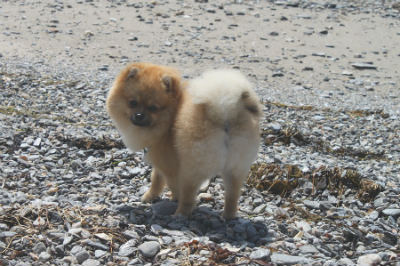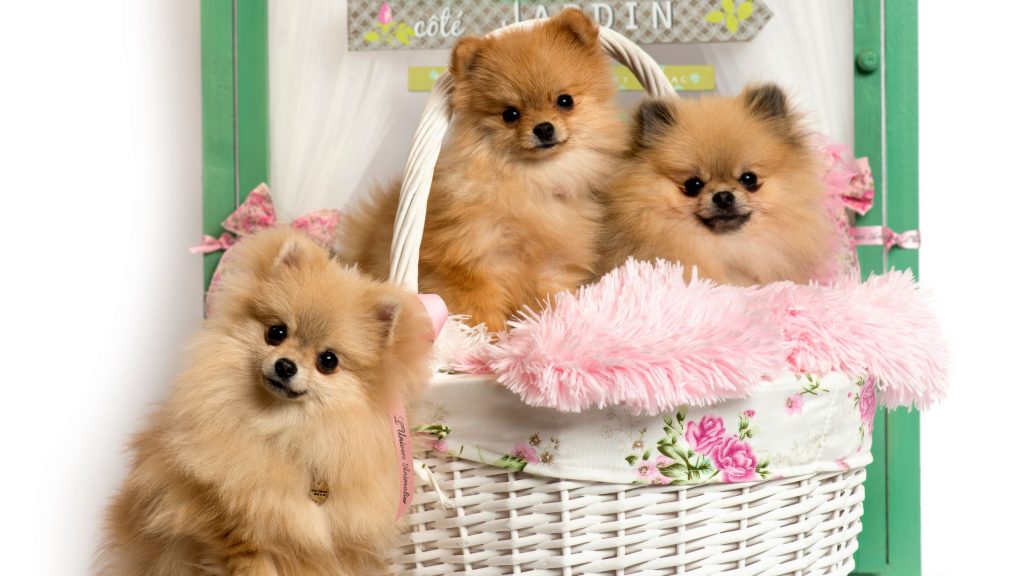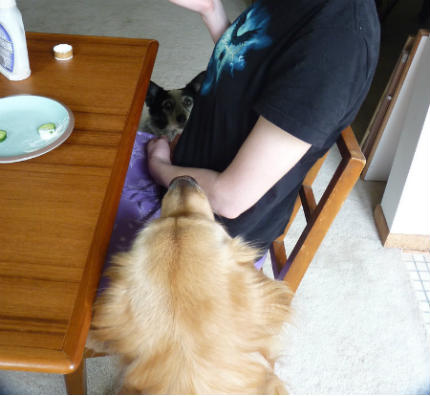Under the name of German Spitz we have five separate breeds , but the FCI has decided to put them in the same standard with some differences between them, although what most distinguishes them is the size. We are going to focus on three, leaving aside the wolf type and the Pomeranian.
- Weight : from 2.5 to 22 kilos, depending on the variety
- Hair type : long and straight
- Character : affectionate, active and sociable
- Health : very good
- Life expectancy : 12 to 14 years
origins
It is nothing new that the origins of a breed are not well defined and those of the German Spitz are no exception, although it is believed that it could descend from Stone Age dogs.
These dogs were known as "spitz of the lake communities", so they may be the oldest breed in what we today call Central Europe.
The German Spitz and the rest of its varieties such as the small, medium or large Spitz are classified as primitive type dogs , as is the case with those that come from that dog from the lake area.
The reason they are called that is because they look a lot like the wolf. They have raised ears, the snout ends in a point and the tail always goes over the back. In Europe, all Spitz are of the breed in question, with the exception of theVolpino Italiano .
Its popularity in the West is due to Queen Charlotte, wife of George III of England. With her the German Spitz arrived at the English court, becoming known in all the palaces.
Right now, outside of Germany they are not very famous, except for the smallest breed, called Pomeranian or Dwarf Spitz, as it has become a highly appreciated pet.

Main features
The characteristics of these dogs, whether the medium Spitz, the large Spitz or the small German dog, which in this case would be the small Spitz , are the same in all cases. Only its size varies and also the available colors or its arrangement.
One of their most characteristic parts is the head, since these dogs look like foxes. The stop (the area that joins the skull to the nose) is marked and the nose is round, very small.
His eyes are medium-sized, oblique and dark. As for the ears, they are erect, set very high and are triangular like those of other primitive breeds, for example, the Shiba Inu.
If we look at it from the side we will see that it is square, with a short and very strong back. The chest is deep and well muscled, while the tail is rolled over the back and is covered with a lot of hair, being another of its identity signs,
It has a coat with two layers . The interior is dense, short and looks very similar to wool. The one on the outside has longer and more separated hair.
The colors that are accepted are not the same in all varieties:
- Large Spitz: can be black, white or brown.
- Medium Spitz: the same colors are accepted plus black with tan, orange, grayish, cream or cream sable.
- Small Spitz: has the same shades as the medium one.
Regarding the height at the withers, the small variety measures around 26 cm; Those cm rise to 34 in the medium Spitz and reach 46 in the large one.
Character of the German Spitz
The temperament of the three varieties or sizes is very similar. They are happy dogs , very attached to their families and at the same time reserved with strangers, quite barking.
That can be good for us if we live in the countryside, because although they do not protect, they do alert us when they see something strange. However, if we are going to live with the German Spitz in the city, we must take this into account.
They tend to be problematic with dogs of the same sex, which is not the case with household pets, which the German Spitz considers its family.
We must work to ensure that they tolerate dogs outside, focusing on socialization from when they are very young.
If we have small children at home, it is better to look for another breed , as they cannot stand the abuse that younger ones subject them to. In fact, they usually react badly to this situation, going so far as to bite if they feel they are being mistreated.
Another thing is that we are talking about older children, over 10 years old. In this case, they will become inseparable playmates.

Care
The hair is what will give us the most work , especially in the large Spitz, which is the one with the largest coat.
In fact, it is recommended to comb it every day to prevent tangles from occurring. During the shedding season, it is advisable to do it up to two times in the same day, otherwise the house will be full of hair.
They adapt very well to life in apartments, especially the small Spitz. For the medium and large German Spitz it is better to have a garden, even if it is not large.
They are going to ask us for a walk, plus the two largest varieties and everyone, regardless of their height, has a problem with the heat. Because of the wool blanket they have as an undercoat, heat is not the best for them.
We are going to take this into account, because if we live in an area with very hot summers it may not be the best breed in our case.
Feeding
Their feeding needs differ quite a bit and are in accordance with the size of the German Spitz that we have at home.
If we decide on the small one, we must buy specific feed for mini breeds . The reason is that “normal” food has a kibble that is too large and hard for the mouths of mini dogs, let alone puppies.
The medium and large ones will be able to eat specific feed, although they will not have problems breaking any type of kibble.
We will acquire a premium feed, with a good composition in which the main part is meat and not by-products. Here, it is possible that in the case of the small Spitz you will have to try several brands until you find the ideal one.
Because of his hair, it would be advisable to give him some supplement. If we see that his coat does not shine with dog food, we can add a splash of olive oil to his food several times a week.
Another option is to look for a brand that supplements its formula with oils or even switch to one of those feeds that are made only of fish , as they will have a high content of fatty acids.
German Spitz Health
The health of the German Spitz is very good and that is no coincidence. This comes from the same moment in which the standard was written, since no exaggerated features were reflected in it, as happens with other races.
In fact, they look like foxes, an aspect in which functionality has taken precedence over aesthetics .
Yes, there are some problems, but not specific to the breed, but rather the type that any dog can suffer from, even mixed breeds.
One of them is patella luxation , a disease that occurs in almost all races. It is more common in the Miniature Spitz, although it can occur in the medium and large Spitz.

The mouth causes problems in the small Spitz
Of all, perhaps the most delicate is the small Spitz. In fact, your mouth can be a source of problems, starting with impacted teeth when they begin to move.
Another disease has to do with the early loss of teeth . This happens to small breeds, although you can make the teeth last longer with regular cleanings at the vet.
They are no strangers to hip dysplasia
It seems to be a curse of all medium and large breeds, so the German Spitz of these sizes can also suffer from hip dysplasia .
It is true that due to its morphology the possibilities are less than those of other breeds, such as the German Shepherd, but we always have that risk.
The best way to avoid this is to ask for proof from the parents when we buy a copy. Both must be free of dysplasia and if possible we will ask for the grandparents' certificates as well.
Other dog breeds that may interest you:












